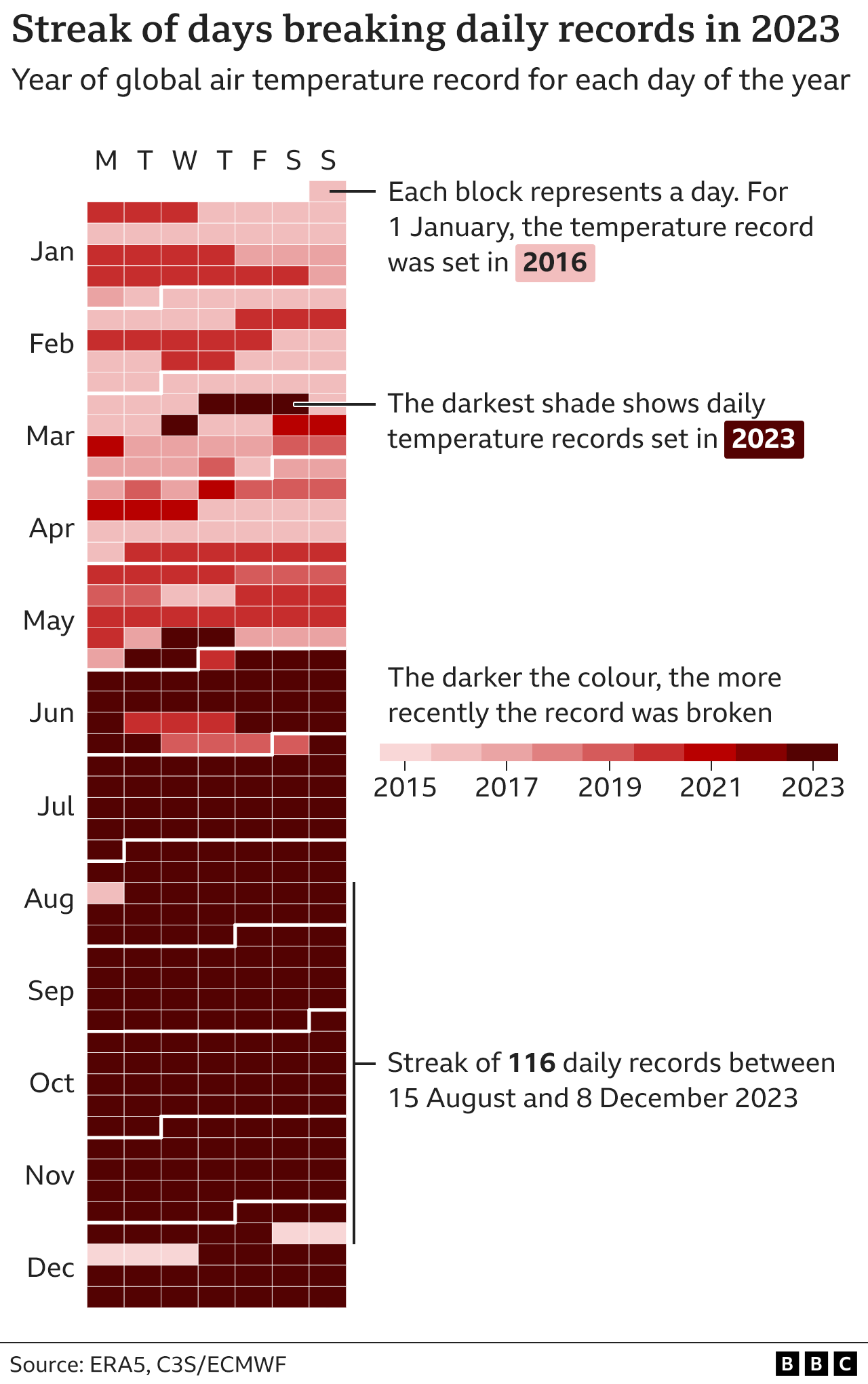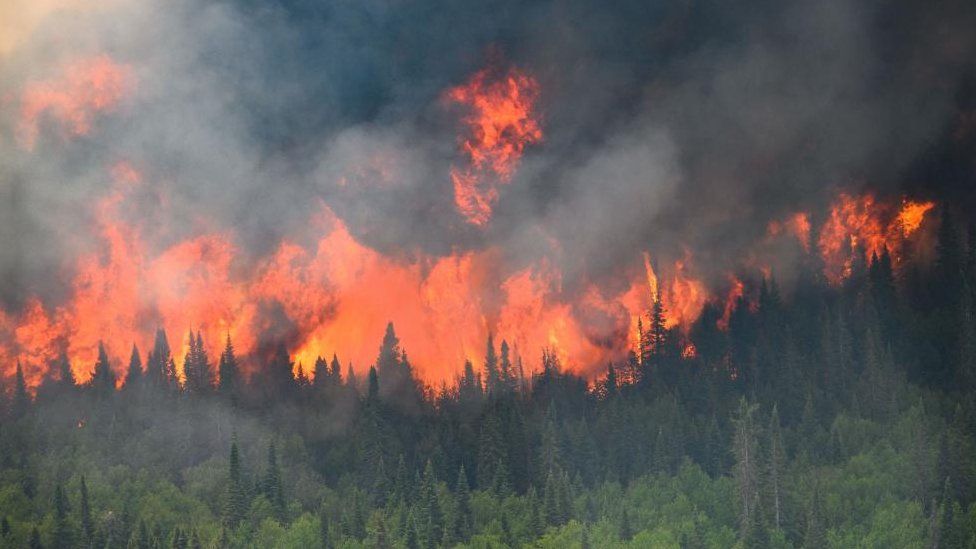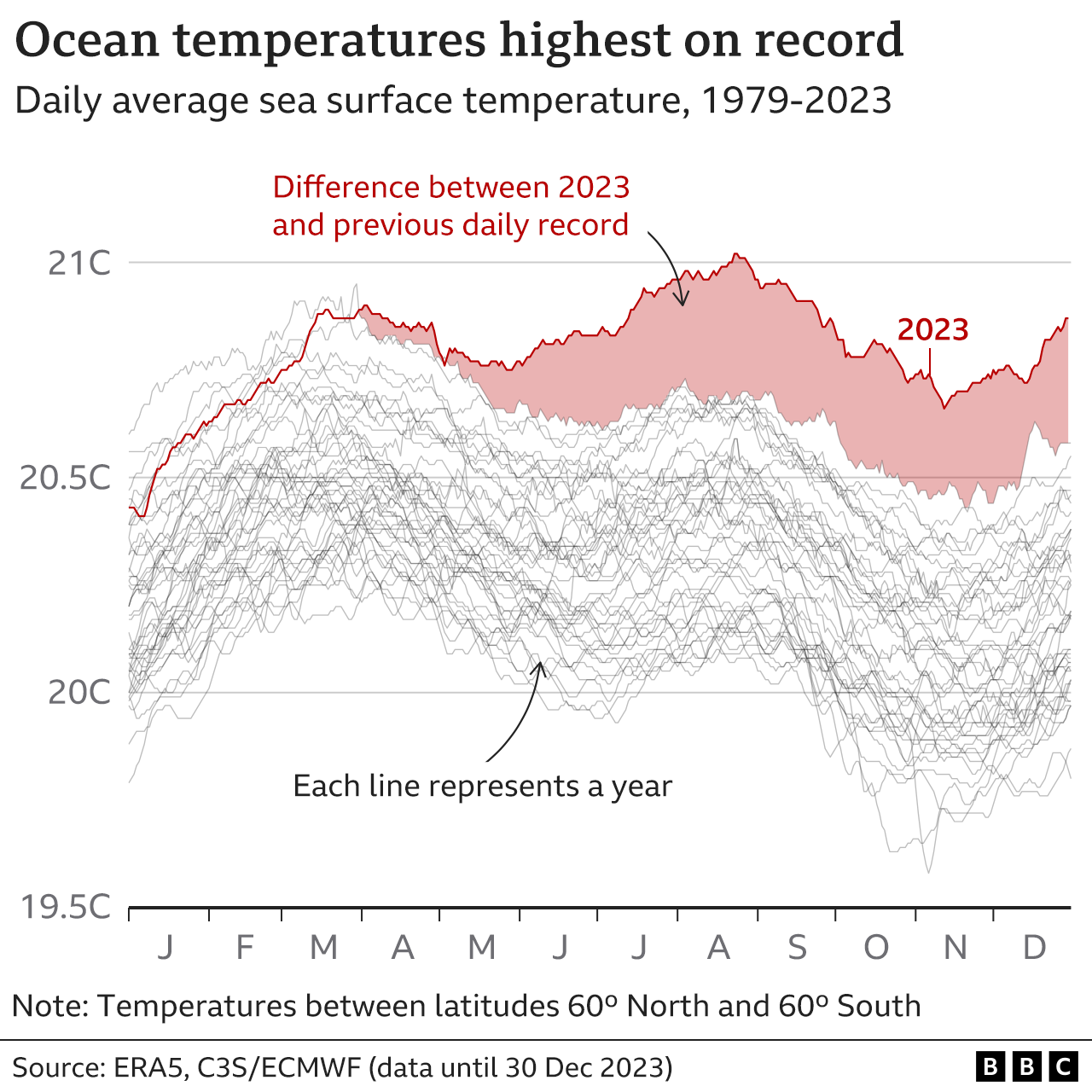The year 2023 has been confirmed as the warmest on record, driven by human-caused climate change and boosted by the natural El Niño weather event.
Last year was about 1.48C warmer than the long-term average before humans started burning large amounts of fossil fuels, the EU’s climate service says.
Almost every day since July has seen a new global air temperature high for the time of year, BBC analysis shows.
Sea surface temperatures have also smashed previous highs.
The Met Office reported last week that the UK experienced its second warmest year on record in 2023. These global records are bringing the world closer to breaching key international climate targets.
“What struck me was not just that [2023] was record-breaking, but the amount by which it broke previous records,” notes Andrew Dessler, a professor of atmospheric science at Texas A&M University. The margin of some of these records – which you can see on the chart below – is “really astonishing”, Prof Dessler says, considering they are averages across the whole world.

An exceptional spell of warmth
It’s well-known that the world is much warmer now than 100 years ago, as humans keep releasing record amounts of greenhouse gases like carbon dioxide into the atmosphere.
But 12 months ago, no major science body actually predicted 2023 being the hottest year on record, because of the complicated way in which the Earth’s climate behaves. During the first few months of the year, only a small number of days broke air temperature records. But the world then went on a remarkable, almost unbroken streak of daily records in the second half of 2023.
Look at the calendar chart below, where each block represents a day in 2023. Records were broken on the days coloured in the darkest shade of red. From June, we’re looking at a new record most days.

More than 200 days saw a new daily global temperature record for the time of year, according to BBC analysis of Copernicus Climate Change Service data.
This recent temperature boost is mainly linked to the rapid switch to El Niño conditions, which has occurred on top of long-term human-caused warming. El Niño is a natural event where warmer surface waters in the East Pacific Ocean release additional heat into the atmosphere.
But air temperatures have been boosted unusually early on in this El Niño phase – the full effects had not been expected until early 2024, after El Niño had reached maximum strength.
This has left many scientists unsure about exactly what is going on with the climate. “That raises a bunch of really interesting questions of why [2023 was] so warm,” notes Zeke Hausfather, a climate scientist at Berkeley Earth, a science organisation in the US.
Consequences felt worldwide
Another notable feature of the 2023 warmth is that it has been felt pretty much worldwide.
As the map below shows, almost all of the globe was warmer than recent 1991-2020 levels – a period that was itself nearly 0.9C warmer than before humans started burning large amounts of fossil fuels in the late 1800s.

This record global warmth has helped to worsen many extreme weather events across large parts of the world in 2023 – from intense heatwaves and wildfires across Canada and the US, to prolonged drought and then flooding in parts of east Africa.
Many occurred on scales far beyond those seen in recent times, or at unusual points of the year.
“These are more than just statistics,” says Prof Petteri Taalas, the Secretary General of the World Meteorological Organization between 2016 and 2023. “Extreme weather is destroying lives and livelihoods on a daily basis.”

The temperature of the air is only one measure of the Earth’s rapidly changing climate. Also in 2023:
- Antarctic sea-ice hit a ‘mind-blowing low’ with Arctic sea-ice also below average.
- Glaciers in western North America and the European Alps experienced an extreme melt season, adding to sea-level rise.
- The world’s sea surface hit its highest record temperature amid multiple marine heatwaves, including the North Atlantic.
In fact, the world’s ocean surface has been on an unbroken streak of record-breaking days since 4 May, BBC analysis of Copernicus data shows. As the chart below illustrates, many days have seen records broken by a huge margin.

A warning for 2024 and beyond
The year 2024 could be warmer than 2023 – as some of the record ocean surface heat escapes into the atmosphere – although the ‘weird’ behaviour of the current El Nino means it’s hard to be sure, Dr Hausfather says.
It raises the possibility that 2024 may even surpass the key 1.5C warming threshold across the entire calendar year for the first time, according to the UK Met Office.
Nearly 200 countries agreed in Paris in 2015 to try to limit warming to this level, to avoid the worst effects of global warming. It refers to long-term averages over 20 or 30 years, so a year-long breach in 2024 wouldn’t mean the Paris agreement had been broken. But it highlights the concerning direction of travel, with each hot year bringing the world closer to passing 1.5C over the longer term.
Human activities are behind this long term global warming trend, even though natural factors like El Niño can raise or reduce temperatures for individual years, and the temperatures experienced in 2023 go far beyond simply natural causes.
Look at the chart below. At the time, 1998 and 2016 were record-breaking years, boosted by strong El Niño warming. But these don’t come close to the new 2023 records, marked in the darkest reds.

“2023 was an exceptional year, with climate records tumbling like dominoes,” concludes Dr Samantha Burgess, Deputy Director of the Copernicus Climate Change Service.
This latest warning comes shortly after the COP28 climate summit, where countries agreed for the first time on the need to tackle the main cause of rising temperatures – fossil fuels.
While the language of the deal was weaker than many wanted – with no obligation for countries to act – it’s hoped that it will help to build on some recent encouraging progress in areas like renewable power and electric vehicles.
This can still make a crucial difference to limit the consequences of climate change, researchers say, even though the 1.5C target looks likely to be missed.
“Even if we end up at 1.6C instead, it will be so much better than giving up and ending up close to 3C, which is where current policies would bring us,” says Dr Friederike Otto, a senior lecturer in climate science at Imperial College London.
“Every tenth of a degree matters.”
(BBC)








